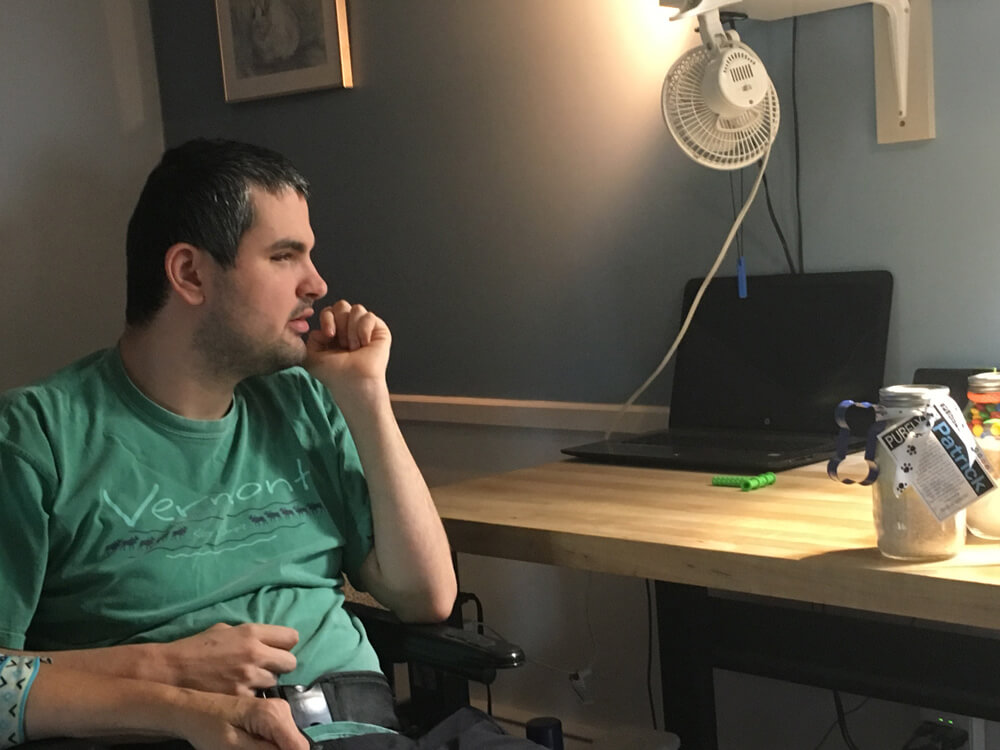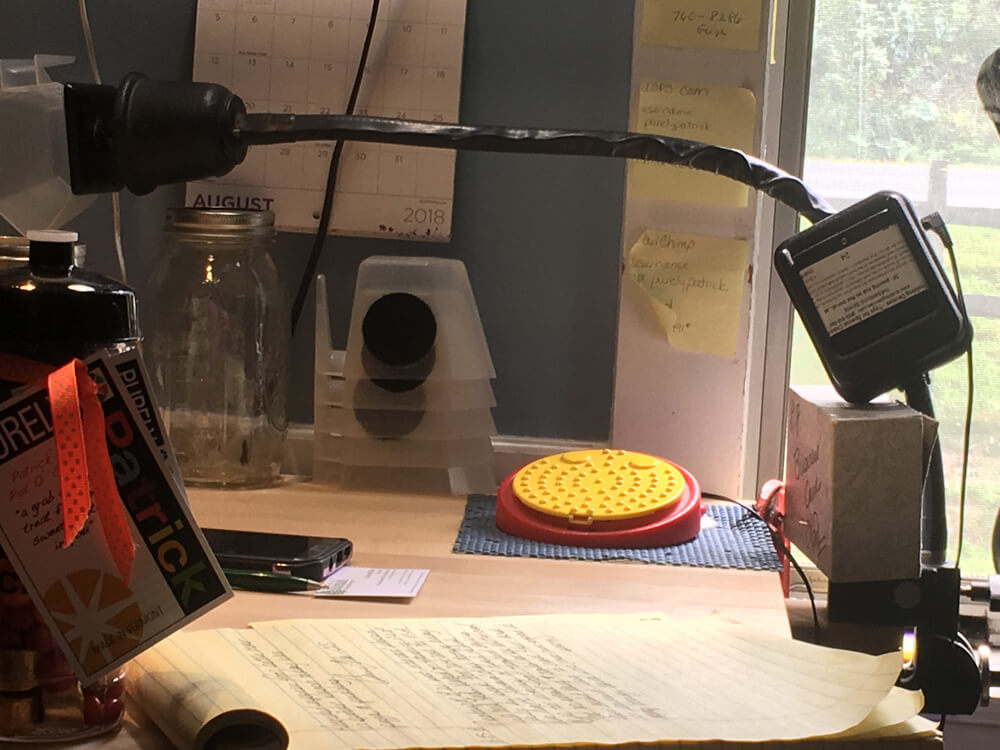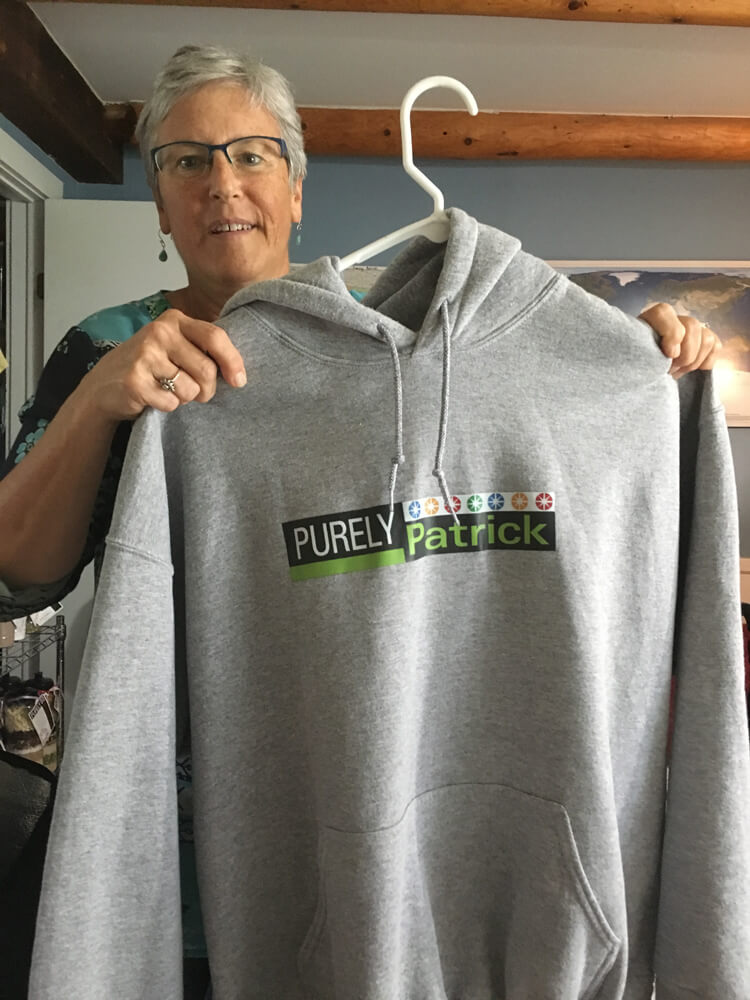717 Maple Street
Stowe, VT 05672W
www.purelypatrick.com
purelypatrick@gmail.com
Phone: 802-477-3928
Founder: Mary Anne Lewis (Mary Anne and husband George, operate the Brass Lantern Inn Company is named for son Patrick Lewis.
Job Coaches: Carrie Cota; Miranda Maxham.Phone: 802-477-3928
“Purely Patrick is a one-person business run by Patrick Lewis, 27, (with the help of his mother and two job coaches) from his room in his parent’s Brass Lantern Inn. Patrick is a young man disabilities and many abilities who assembles and sells various products including kits for soups, cookies and dog biscuits through the use of assistive technology. He uses a pouring device that is activated by a switch that he controls. The company sells products online, at various local fairs and at the inn.”
My Visit/History of Purely Patrick:
I met with Patrick, his mother, and job coach, mostly in his bedroom/ work space. Patrick’s mother is an occupational therapist by training and worked in Baltimore, MD for many years. His parents decided to make a change and searched to purchase an inn in the northeast. They purchased the Brass Lantern Inn and moved to Stowe, VT in December, 2009. Patrick was 19 years old when they moved to Stowe and he started at Stowe High School. He is considered to be “one of the 25 most disabled people in Vermont.” Mother notes that in Baltimore, individuals like Patrick were filling plastic bubbles (packages) with toys (for vending machines) at a school for the blind, putting labels on products, and putting tops on eye droppers (Mom shared her feeling about this program with me by saying, “Boy, shoot me if you make me do this kind of thing!”) She didn’t want to see Patrick doing this type of work for the rest of his life. In Vermont, an option for Patrick was to attend a medical day care center, but he would have been with people of all ages and abilities and his specific needs wouldn’t have been met (“It is very group oriented and they will do a craft activity or movie but will do the activity hand over hand without accommodations for a child who is blind”). Mom considers her family to be lucky to be in Vermont, in terms of services offered and due to what she describes as “tiered funding.”
Through Mary Anne’s involvement on the board of the Lamoille County Mental Health Services, and through good advocacy, she was able to secure 25 hours a week of job coaching services, and is able to split the time between two wonderful, long-term coaches, Carrie (who was present at our interview) and Miranda. They also receive 28 hours a week of respite care, and there is an adaptive transportation fund, which provides for an adapted van and related products and services like snow tires and inspection.
Mary Anne was an important resource to the school in planning Patrick’s curriculum and vocational training. Mom carefully considered what Patrick could do and observed that he can make (what she calls) “hand farts,” a movement he does with his hands. She then asked “What can he do with the movement to make it vocational? Why can’t he mix bath salts in a zip lock bag?” Patrick has a pouring device where he hits a switch and it pours raw ingredients through a funnel into a container. He began making bath salts, and his job coach insured measurement accuracy. The bath salt containers sold for $1 at the Inn, the school for the blind, and other locations. Then, such salts were banned as children began abusing them through snorting.
“Then came the dog biscuit phase,” reports mom, which was easier than baked goods due to different health standards (for dog biscuits) “but it was too moist.” Patrick would make it known that he didn’t like touching the dog biscuit dough. He was using a cookie cutter which needed hand over hand, so it was not easy for him. Plus, baking at the inn’s kitchen had a stench. Mom maintains her good sense of humor and observes, “We had contraband bath salts, and he was not enjoying dog cookies…”
Mary Anne had hired a graphic designer, Sally Stetson, around this time to do some work for the inn. She designed business cards, shirts, etc. Mom shared her efforts to create the ideal job and product for Patrick to work on. “What if they assembled ingredients which people could make at home?” Mary Anne searched and found many recipes online. “It kept evolving. I made cookies and soups for teacher gifts over the years and thought, ‘Patrick can do this!”
Mary Anne and Carrie report that their initial five products evolved in to the 22 they now carry. Two are gluten free. “It snowballed! Sally helped us with the hang tag, banner for farmer’s market, business cards—it was all Sally!” The company continues to evolve in terms of products, presentation, shipping and support of other organizations. “We have gotten creative with color, ribbons, a sunshine and compass theme, we have put his story on the back of the card.”
They have continued to work with an employment specialist to continue completing proper forms with the state to justify funding for Patrick’s venture. They have created a business plan (“easy to understand, scaled down”), did a feasibility study which was presented to the state, and asked for 25 hours per week of job coaching—so there was time to swim and ski.” Mary Anne reports that Vermont has swung to an inclusion model which requires Patrick to spend most of his time with people without disabilities. Mary Anne and Carrie report, “The state only allows one peer with a disability—by law; EVEN if the three kids with different disabilities would get along well and complement each other… if not, it is sheltered workshop mentality. VT is very strongly against anything resembling this in any way. We comply so we won’t jeopardize his funding.” (They share details about strict guidelines and how Carrie, the community integration specialist and supportive employment specialist, works “creatively” to both comply with and push the boundaries.
Methods of packaging and shipping have also evolved, from zip loc baggies with no visual presentation, to gusseted bags with cellophane- reinforced bottoms (which they then learned will “blow up” in the nonpressured cargo area of the plane), to 16 and 32 ounce jars. They now package and ship their products in water bottles, which can later be reused.
Patrick sells online, at famers markets and at the Brass Lantern Inn. Thy have recently begun using Grandma Joe’s Snickerdoodles recipe which they put in a jar with purple ribbons as a fundraiser for the Vermont Walk to End Alzheimer’s. To date, Patrck has donated more than $600. Mary Anne shares a beautiful story of a multiply handicapped girl, a spastic quadriplegic with cerebral palsy who was nonverbal and visually impaired. She had worked with the girl, Raquel, in Baltimore in her role as an occupational therapist. The family was brainstorming ideas for a “mitzvah project” and realized she had beautiful hair which she then grew long and donated to Locks of Love, to benefit patients who have lost hair due to cancer treatments.
Mary Anne and Carrie are pleased with the success of the business but are having difficulties gaining a presence in stores. They like the idea of being connected to others in similar businesses which employ young adults with disabilities.
From website:
Don’t DIS my ABILITY
Products with passion
Profits with purpose
Specialty food items, bringing you a taste of Vermont!
I have Cerebral Palsy and even though I do not talk, I always get my point across! My hands “see” what my eyes cannot. Watch me make these products for you…
Message from Patrick:
Hi! My name is Patrick Lewis. I love to listen to music, spend time outside, sing, swim, and participate in adaptive skiing. I have even participated in several triathalons with help. I enjoy spending time with my family. I enjoy making these products and I hope you will enjoy them too!
My products are made by the use of assistive technology. I use a pouring device that is activated by a switch that I control. I have the help of my mother and 2 job coaches to ensure the measurements of my products are correct.
I participate in local craft fairs and farmer’s markets. My “Made in Vermont” products are done so with care and determination to ensure that they are the absolute best experience for my customers.
Message from my Mom:
Patrick was born 3 1/2 months premature. He was a “fighter” and a “lover” from the very beginning. As he grew, so did his list of diagnosis, but we soon learned to look past those and see Patrick for who he is. Patrick has used “switches” to control his environment for a long time. He has one switch that controls his music, another that turns on his fan and another that runs his blender. He also has another switch that is hooked up to a measuring cup on the end of a gooseneck. Patrick has used this device for years to help water the plants, help pour the milk for a milkshake, etc. As an Occupational Therapist, I was constantly thinking “what could Patrick do vocationally, with his switches?” And then it came to me that he could make layered jars of cookies, soups, etc., using his “pouring switch”. And thus, Purely Patrick was born. Patrick truly is a cheerful soul, who always has a song in his heart (and is always literally singing!). He is our “ambassador to life” and brings a smile to all who meet him!
Lessons Learned/Observations:
- Pendulum has swung toward inclusion (in State of Vermont) and you must be very careful to follow strict rules and guidelines (i.e. By law, state only allows one peer with a disability; rest of group must not have a disability. EVEN if the three kids w/different disabilities would get along well and complement each other, they cannot be together. This is “sheltered workshop mentality.” Not complying can jeopardize his funding!
- Realistically assess what your child can do; look for his strengths and areas of interest: Patrick made “hand farts”—a certain movement he does. Mom asked “what can he do with the movement to make it vocational.” Why can’t he mix bath salts? This was the first step in Purely Patrick’s growth.
- Be careful of what you wish for in terms of interest in the company and its products. Interest may explode. This is a good problem!
- We are true to the name of the company—“Purely Patrick” means only Patrick put it in the jar. No other staff puts items in the jar, even if we can’t keep up with the demand. Since Patrick is human like the rest of us, there are some days when he doesn’t want to work and is less productive. It is about him and we have to follow Patrick’s lead. Some days, he can fill 15-22 jars in a shift; other days, only 2 or 3.
- Websites are very expensive—we would like to redo the website but it is costly.
- There are seasonal ups and downs–during seasonal lulls (January to May)we get creative and push whatever we can: we focus on Valentine’s Day, Easter, and push what you can whenever you can (teacher gifts, shower favors, Mother’s Day, Father’s Day, anniversary gifts, etc.); November through the end of December is a busy month-huge orders come in for holiday gifts including doctors who order gifts for their whole staff)
- We sometimes have Patrick use his communication device at markets since this enables him to speak –and it engages passersby who wonder where the sound is coming from!
- We carry product liability insurance (lots of hands in pot—what if a thumbtack falls in to a jar?)
- Ask if Health inspection needed? (in VT, you need it if you have 10 or more employees. Here, Carrie the job coach handles the product and Patrick uses the switch)
- Check issues of shipping across state lines (vs selling at farmers mkt). no need for nutrition label, fat, carbs, etc. in this case, since 1or 2. They file an FDA exemption for nutritional labeling annually (they post ingredients on top and additional info on hang tag—gluten, nuts, etc)
- Investigate shipping options to keep costs down: shipping by US Postal Service is the cheapest method by far. For regional shipping, a good way to ship is Regional Box A-Offered by the USPS®– Priority Mail Regional Rate Boxes are a low-cost shipping alternative for customers who purchase and print shipping labels online. Regional Rate Boxes provide shippers with a low cost mail class for packages traveling short distances. Pricing for Regional Rate Boxes is zone-based.
- Know the shelf life of products and rotate stock. Patrick’s products have a 1 year shelf life.
- Be creative in thinking about how to spend earnings and other monies received. Remember there are equipment needs including a table, computer, and printer. Keep a running wish list (i.e. a new tent for fairs) IF he has surplus money at end of year.
- For accounting and tax purposes, remember that anything in inventory is an asset which needs to be reported
- Know the tax laws—we pay quarterly state taxes on dog treats, bird seeds and shipping, which are taxable but not on food items, as they are not taxable.
- Even people with disabilities can be charitable! Patrick has donated over $600 to the Vermont Walk to End Alzheimer’s and has purple tags and ribbons on Grandma Joe’s Snickerdoodle cookies indicating that he donates a percentage of sales to charity.
- Company would like to find new markets. Has been hard to get an in store presence.
- Being connected to other people in similar businesses would be very useful.







